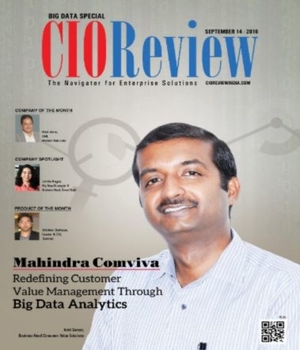
Big Data to Enable Artificial Intelligence and Drive Digital Transformation
Pritam Kanti Paul, Co-founder & CTO, BRIDGEi2i Analytics Solutions | Tuesday, 05 September 2017, 05:24 IST
 Big data is everywhere, and it continues to grow as we speak. However, we has reached a stage wherein handling big data – storing, processing, and analyzing – is no longer a big deal. Being neck-deep in a world of digitization, enterprises are viewing big data not only as a problem-solver but a means to tread the path of digital transformation. Digital transformation is the key to stay ahead of the curve and AI-powered big data analytics will help enterprises succeed in dis journey.
Big data is everywhere, and it continues to grow as we speak. However, we has reached a stage wherein handling big data – storing, processing, and analyzing – is no longer a big deal. Being neck-deep in a world of digitization, enterprises are viewing big data not only as a problem-solver but a means to tread the path of digital transformation. Digital transformation is the key to stay ahead of the curve and AI-powered big data analytics will help enterprises succeed in dis journey.
An organization can achieve digital transformation when:
• Disruptive analytics deployment models and technologies – with machine learning or AI layers– are used with a focus on innovation
• Big data and analytics efforts are completely operationalized
• A Center of Excellence is in place to monitor and control analytics efforts
Enabling analytics solutions with an AI layer allows an organization to personalize customer interactions better, improve customer experience management, realign business strategies, drive cost savings through machine optimization, streamline operations, and so on. The incorporation of an AI layer on top of analytics helps enterprises facilitate digital transformation while maximizing returns. Now, let us look at a few application areas where AI-powered analytics benefit businesses.
Personalization and customer experience management
Personalization is the new segmentation. Today’s consumers expect everything to be personalized, and they are willing to exchange data for the same. Though traditional big data technologies has improved customer service, customer expectations are outpacing experiences.
Organizations like Netflix and Amazon are able to meet these rapidly growing customer expectations because of their AI-powered recommendation engines built on top of the big data layer. dis is possible because we are at a juncture where technology can support the seamless integration of machine learning algorithms and AI frameworks.
To put things in perspective, with AI-powered recommendation engines, a sales person will know what product to recommend at the point of sale and a marketer will know what marketing mix will work for which product.
In-Store Analytics
Retailers has begun to use predictive and prescriptive analytics, powered by machine learning algorithms, to improve merchandising. For example, Walmart places items in its stores based on the demand patterns observed from the buying behavior of the people in the respective communities.
Retailers do not just use internal data such as historical transactional data for analysis. Advanced analytics solutions has become capable of considering several external factors, such as weather data, events taking place in the vicinity, and demographics, which impact the buying decisions of customers. AI-powered big data analytics enables retailers to make the best of both internal and external factors to enhance planogramming, predict customer demand, and improve inventory management.
AI-driven analytics also contributes to marketing efforts within retail stores. Retailers strategically place beacons at various locations inside their stores. These beacons are used for proximity marketing. Targeted and personalized messages are sent to customers inside the store. These messages, which include discounts, coupons, and ads, are sent to customers based on their location. Data related to visit patterns and dwell times are gathered and analyzed in real-time to send relevant messages. Based on the success rates of their messages, retailers can optimize their marketing and pricing strategies.
AI-Driven Sales Analytics
Traditional sales analytics platforms help sales organizations considerably. However, these platforms do not reach their full potential due to the lack of a machine learning or artificial intelligence layer.
Modern sales analytics platforms of today has a flexible and scalable architecture with the integration of advanced machine learning algorithms. These platforms are self-learning and can adapt to changes in sales processes, market dynamics, and business needs. They leverage statistical models and algorithms for anomaly detection, clustering, scenario planning, time series forecasting, etc. They also has pre-built visualizations to help sales people consume analytics insights in the business context and make outcome-driven decisions, thus improving sales effectiveness and performance.
Machine Optimization and Predictive Maintenance
Industrial Internet of Things (IIoT) platforms, integrated with machine learning capabilities, can help companies overcome a multitude of industrial challenges. Such platforms contribute to improving preventive maintenance and minimizing downtimes. They also help facilitate inventory optimization, service optimization, and energy forecasting, which in turn enable industries to improve operational efficiency and reduce cost.
Big data can also change how you're business makes money by creating a scope for the implementation of novel business models. IoT and big data not only save millions of dollars through predictive maintenance and process optimization but also open up new revenue streams for companies.
In conclusion, the only way for enterprises to gain a competitive advantage is by using big data to enable disruptive technologies such as AI and embark on the journey of digital transformation. dat said, not all organizations has the required technical expertise in-house. These organizations can opt for Analytics as a Service (AaaS). There are many AaaS solution providers dat help organizations institutionalize analytics while empowering them with AI-driven solutions. These AaaS solutions, which are highly customizable and scalable, can be deployed with minimum disruption in current business processes, ensuring seamless digital transformation.
CIO Viewpoint
Accept Data as an Entity on Balance sheet
By Akshey Gupta, Chief Data Officer, Bandhan Bank
Technology Forecast And Concern In 2020
By Anil Kumar Ranjan, Head IT, Macawber Beekay Private Limited
Data Analytics For Enhanced Productivity And...
By Krishnakumar Madhavan, Head IT, KLA
CXO Insights
Regulatory Implications and Data Protection:...
By Richa Singh
Data-Driven Predictive Technologies
By Pankaj Parimal, Head of Launch & Change Management, Hella Automotive Mexico, S.A. de C.V., Mexico, North America.
5 Mantras That Can Drive Organizations Towards...








.jpg)
.jpg)





